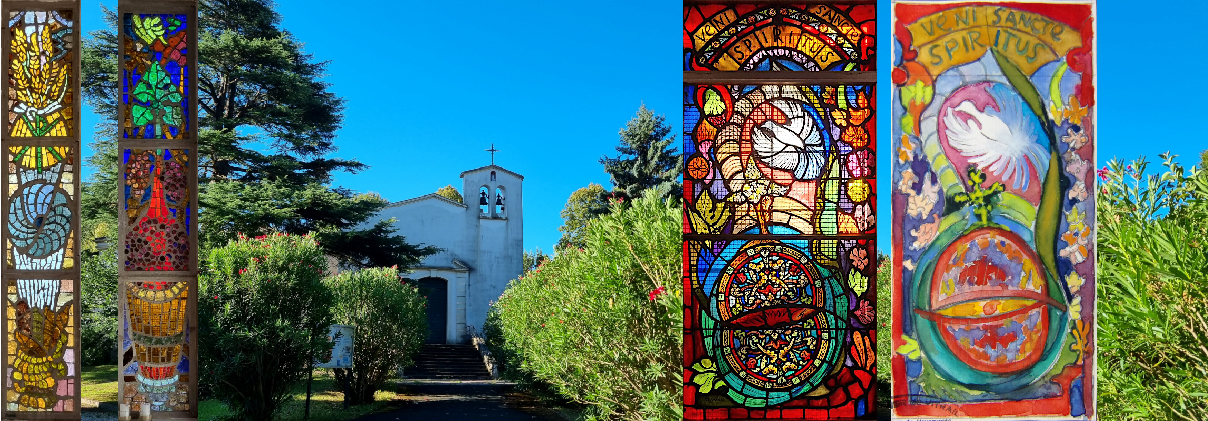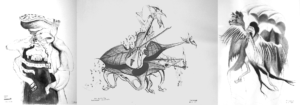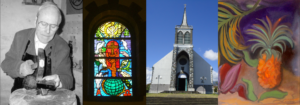FOCUS ON : The stained glass windows of Saint Léon de Marracq
The complete history of this church is explained in the Guide des églises de la province de Bayonne Centre
And to sum up, before being the church of Saint Léon de Marracq, this building was a former chapel which was totally dilapidated. It was the chapel of the castle known as “the Emperor’s residence”. This chapel had to be saved because it had been used for the ordination of young seminarians during the revolution. The foundation stone for the future church was laid in 1952. The chapel was enlarged in the shape of a cross with a roof structure that gave it a modern and harmonious appearance.
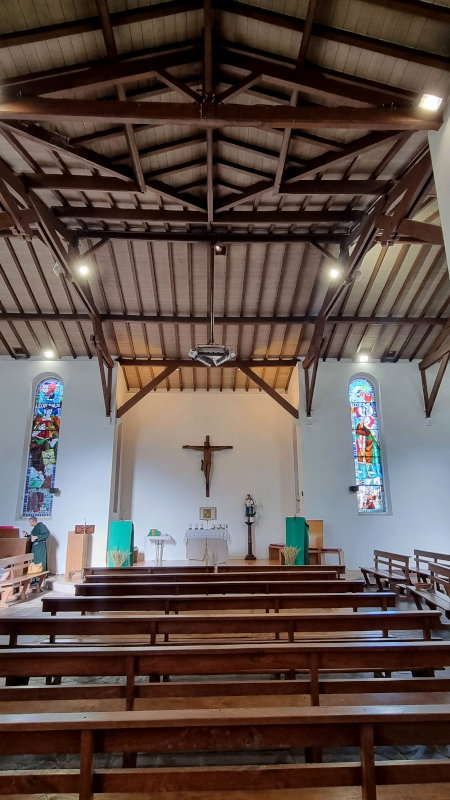
All this was made possible by the help of generous donors. A slab on the floor of the church bears witness to this and pays tribute to them. The text in Basque means: “Your help is the strength of our faith”.

Charles Carrère created three stained glass windows for the church of Saint Léon de Marracq in Bayonne. A leaded stained glass window located behind the baptismal font and two glass slabs located on either side of the altar inside the choir.
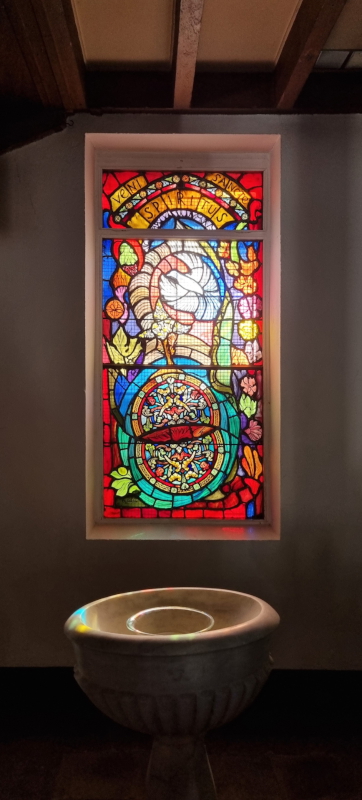
©Janie Cailliau
Stained glass window by Charles Carrère
Saint Léon de Marracq in Bayonne
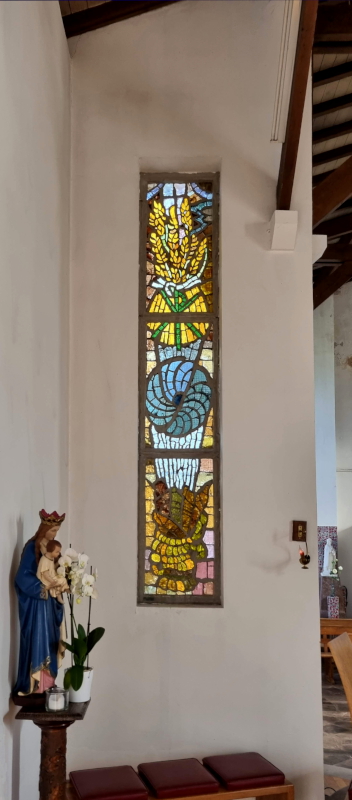
©Janie Cailliau
Stained glass window by Charles Carrère
Saint Léon de Marracq in Bayonne
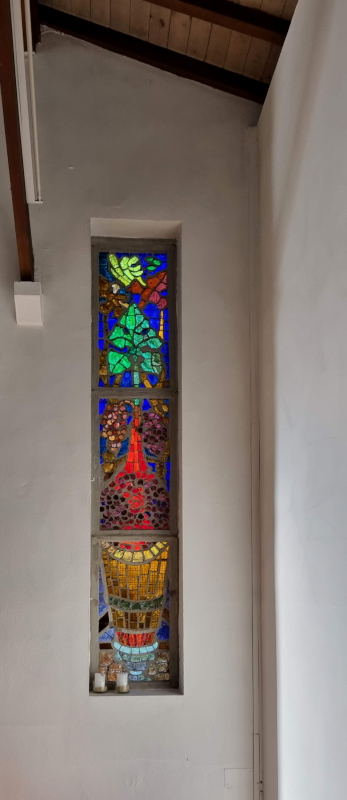
©Janie Cailliau
Stained glass window by Charles Carrère
Saint Léon de Marracq in Bayonne
Charles Carrère explains that to create this leaded stained glass he used pieces of another stained glass window. In a way it is recycling before fashion. Moreover, on his black and white sketch, we can see that he has sketched the shape of the bottom. Then, on the colour model, he suggested the tones to be found in the chosen piece. The “patches or recycled pieces” make the circle that represents the earth.
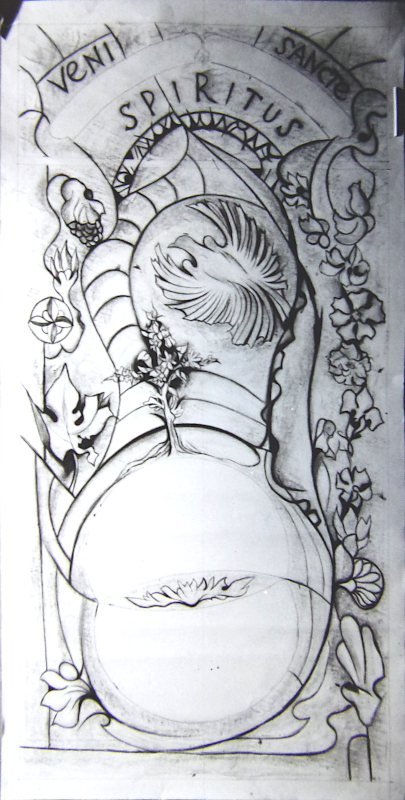
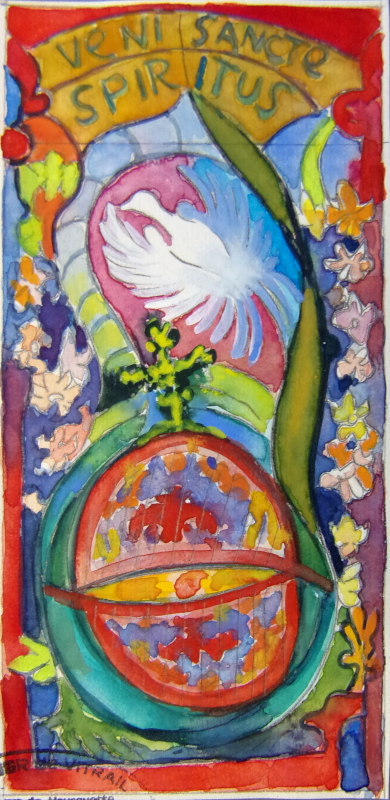

Saint Léon de Marracq in Bayonne
sept 2022 ©JanieCailliau
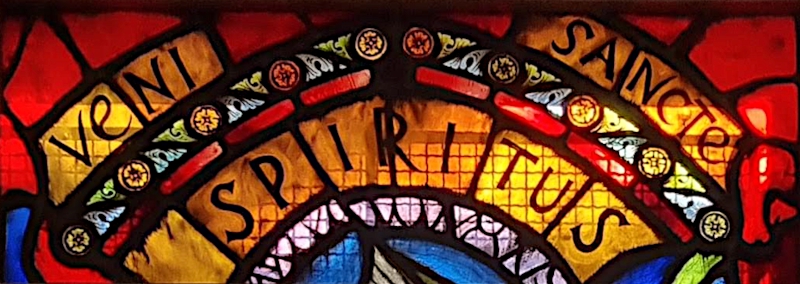
Charles Carrère inscribed “Veni Sancte Spiritus” at the top of the window, which translates as “Come Holy Spirit”. With this quotation, the Master Glassmaker is referring to a sequence of plainsong in the Catholic liturgy reserved for the feast of Pentecost.
At the top is the white dove which embodies the Holy Spirit invoked above.
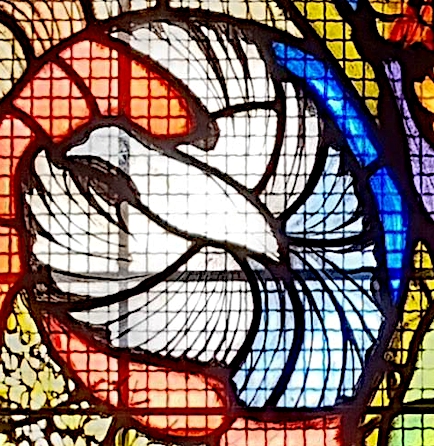
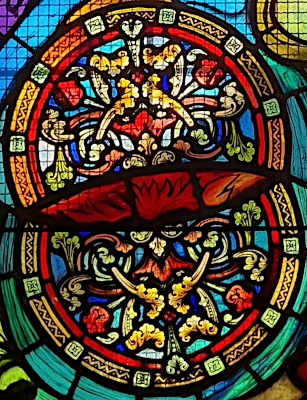
Below is the earth. It consists of two lobes joined by the central fire. Fire is both magma and the living source of light. And all the small pieces recycled with elements of different colours represent the Tohu Bohu, i.e. the primitive chaos or the earth in its initial state.
Charles Carrère has depicted a tree taking root at the top of the earth. It is the tree of incarnation, the tree of life or the vertical link between heaven and earth. It is also the symbol of eternity that draws its strength from the centre of the earth through its roots. The roots have also given rise to other branches which can be found in bloom on either side of the stained glass window.
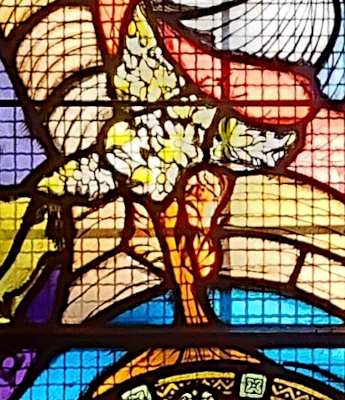
The red background of this stained glass window symbolises the fire of life. It is the colour of the heart and of love, but also of the blood of the martyr. Then there is the presence of water around the earth. Water is the link between the human and the divine. Water is the universal matrix. The first man is born of water and earth, fertilised by the divine breath. And water is also purification and sanctification. This leaded stained glass window is located just behind the Baptismal Font. The choice of symbols is far from random.
The other two windows are glass slabs, i.e. there is no lead but cement (the techniques will be explained in a future Focus).
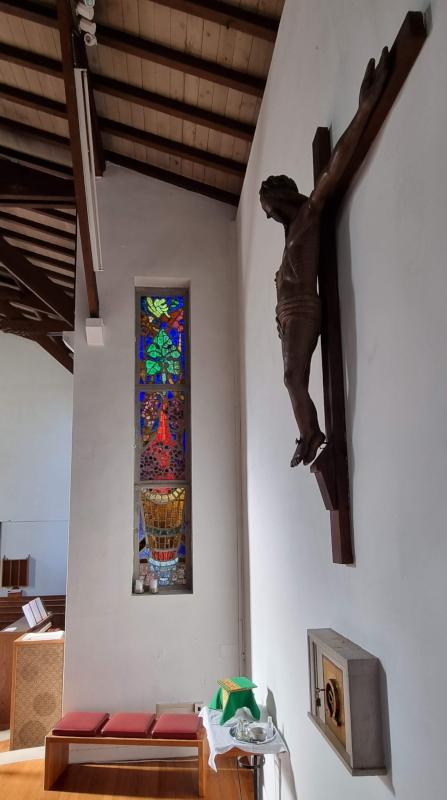
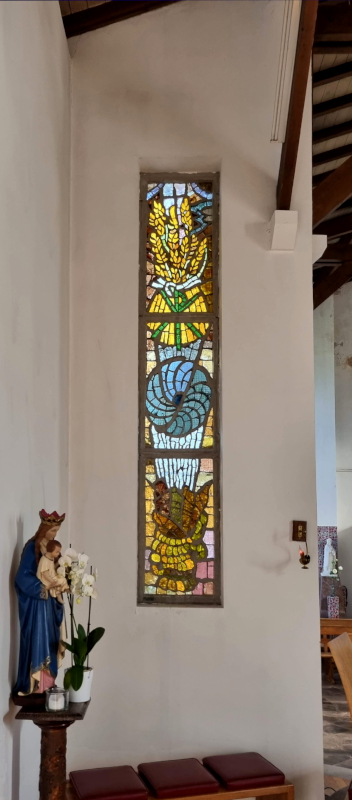
The left-hand window represents the mystical wine press and the right-hand window the mystical mill. The subjects chosen for these glass panels are obvious as they deal with bread and wine and are located in the choir on either side of the altar where the priest blesses the bread and wine in turn.
The Mystic Mill

photo by ©JanieCailliau
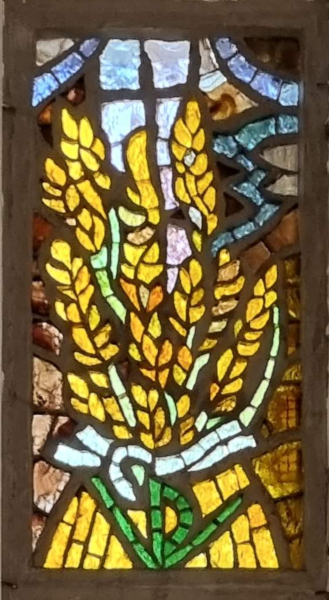
In the upper part of the glass slab Charles Carrère has installed a window. It is the window that lets the light through, implying the divine light that enlightens the spirits and makes the wheat grow. The wheat is represented tied in a bundle and surrounded by a bag.
Charles Carrère has placed the chrism in green, i.e. the name of Christ via the first two letters of his name: the Khi and the Rho
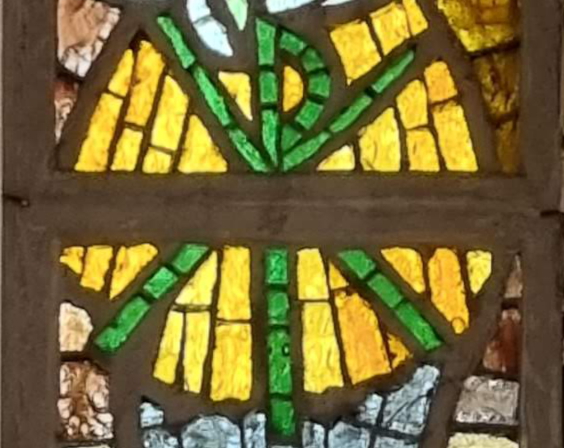
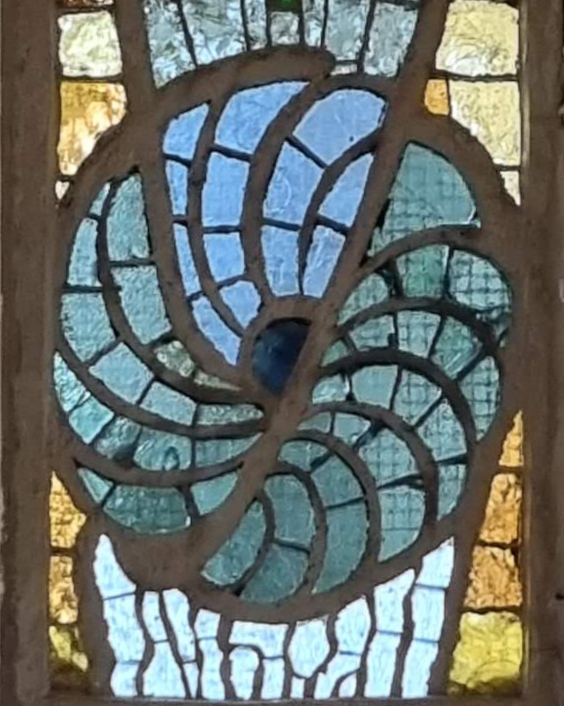
In blue Charles Carrère has represented the stone wheel of the mill. The symbolism of the mystical mill wheel is that Christ came to draw substance from the ancient Law, the Law of Moses, in order to renew the message through the gospels. A famous representation of the mystical mill is on a pillar on the south side of the nave in the Basilica of Vézelay. It is a masterpiece of Romanesque sculpture.
Finally, in the lower part of the glass slab, the basket containing the bread symbolising communion can be seen.

The mystical wine press

Charles Carrère
photo ©JanieCailliau
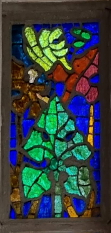
In the upper part of the glass slab, Charles Carrère installs vine leaves, symbols of death and resurrection. Indeed, the green leaves are full of life as seen in spring. But the leaves that turn brown symbolise death before the next resurrection. The Master Glassmaker also uses this symbol as a reference to the cosmic tree in the Garden of Eden with the infinitely large universe. The vine leaf hides and protects the future grape cluster like a mother hides the unborn child in her womb.
In the centre of the glass slab, Charles Carrère places the bunches of grapes and the red juice that flows from them. The bunch of grapes is the community of men among whom Christ was incarnated and lived. The red juice is at once vitality, the blood of life and the blood shed by Christ.
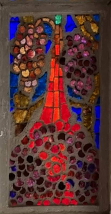
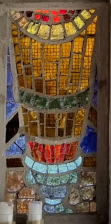
And in the lower part of the glass slab, Charles Carrère has depicted the press for extracting the juice from the grapes. The iconography of the mystical wine presses appeared a little before the 15th century and was spread almost exclusively in Northern Europe. The mystical wine press refers to St Gregory who says “Our Saviour has trodden and been trodden”. This means that Christ treaded on and overcame the demon of temptation to escape his fate. But then Christ was trodden down, his body was broken in torment and the blood flowed like wine in the winepress.
Below the press, Charles Carrère installed the cup or chalice in reference to the wine, the blood of Christ blessed by the priest at the time of the consecration.
Back to the Focus page
Back to the Home page
This post is also available in: French

